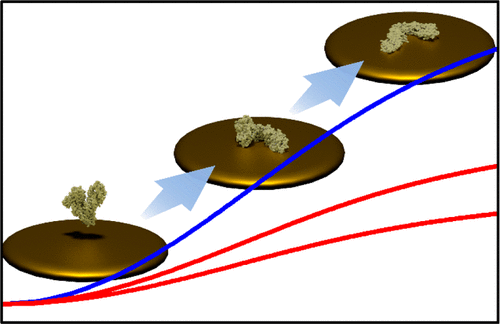当前位置:
X-MOL 学术
›
Anal. Chem.
›
论文详情
Our official English website, www.x-mol.net, welcomes your feedback! (Note: you will need to create a separate account there.)
Indirect Nanoplasmonic Sensing Platform for Monitoring Temperature-Dependent Protein Adsorption
Analytical Chemistry ( IF 7.4 ) Pub Date : 2017-11-20 00:00:00 , DOI: 10.1021/acs.analchem.7b03921 Joshua A. Jackman 1 , Abdul Rahim Ferhan 1 , Bo Kyeong Yoon 1 , Jae Hyeon Park 1 , Vladimir P. Zhdanov 1, 2 , Nam-Joon Cho 1, 3
Analytical Chemistry ( IF 7.4 ) Pub Date : 2017-11-20 00:00:00 , DOI: 10.1021/acs.analchem.7b03921 Joshua A. Jackman 1 , Abdul Rahim Ferhan 1 , Bo Kyeong Yoon 1 , Jae Hyeon Park 1 , Vladimir P. Zhdanov 1, 2 , Nam-Joon Cho 1, 3
Affiliation

|
The development of highly surface-sensitive measurement approaches to monitor protein adsorption across different temperatures would advance understanding of how thermally activated processes contribute to the denaturation of adsorbed proteins. Herein, we established an indirect nanoplasmonic sensing approach to monitor the temperature-dependent adsorption and denaturation of bovine serum albumin (BSA) protein onto a silica-coated array of plasmonic gold nanodisks. A theoretical model was developed to explain how the denaturation of an individual, adsorbed protein molecule influences the localized surface plasmon resonance (LSPR) measurement response and provided an analytical framework to estimate the effect of temperature-dependent protein denaturation on the corresponding adsorption kinetics. The sensing performance of this measurement platform was also characterized across the tested range of temperatures. With increasing temperature (up to 50 °C), it was observed that adsorbed proteins undergo greater denaturation. Circular dichroism spectroscopy and dynamic light scattering experiments verified that individual BSA monomers in bulk solution had increasingly lower conformational stability at higher temperatures within this range, which correlated with the extent of denaturation in the adsorbed state. At higher temperatures, distinct kinetic profiles arising from multilayer/aggregate formation on the sensor surface were also detected. Taken together, our findings identify that the high surface sensitivity and temperature stability of LSPR sensors make them broadly useful analytical tools for monitoring thermally activated biomacromolecular interaction processes.
中文翻译:

间接纳米等离子体传感平台,用于监测温度依赖性蛋白质的吸附
高度表面敏感的测量方法的发展来监测蛋白质在不同温度下的吸附将促进对热活化过程如何促进吸附的蛋白质变性的理解。在这里,我们建立了一种间接的纳米等离子体传感方法,以监测牛血清白蛋白(BSA)蛋白在二氧化硅涂覆的等离子体金纳米磁盘阵列上的温度依赖性吸附和变性。建立了理论模型来解释单个吸附蛋白分子的变性如何影响局部表面等离振子共振(LSPR)测量响应,并提供了一个分析框架来估算温度依赖性蛋白变性对相应吸附动力学的影响。在整个测试温度范围内,还对该测量平台的传感性能进行了表征。随着温度的升高(高达50°C),已观察到吸附的蛋白质会发生更大的变性。圆二色光谱和动态光散射实验证明,在该范围内的较高温度下,本体溶液中的各个BSA单体的构象稳定性越来越低,这与吸附状态下的变性程度有关。在更高的温度下,还可以检测到传感器表面上形成多层/聚集体而产生的独特动力学曲线。在一起
更新日期:2017-11-20
中文翻译:

间接纳米等离子体传感平台,用于监测温度依赖性蛋白质的吸附
高度表面敏感的测量方法的发展来监测蛋白质在不同温度下的吸附将促进对热活化过程如何促进吸附的蛋白质变性的理解。在这里,我们建立了一种间接的纳米等离子体传感方法,以监测牛血清白蛋白(BSA)蛋白在二氧化硅涂覆的等离子体金纳米磁盘阵列上的温度依赖性吸附和变性。建立了理论模型来解释单个吸附蛋白分子的变性如何影响局部表面等离振子共振(LSPR)测量响应,并提供了一个分析框架来估算温度依赖性蛋白变性对相应吸附动力学的影响。在整个测试温度范围内,还对该测量平台的传感性能进行了表征。随着温度的升高(高达50°C),已观察到吸附的蛋白质会发生更大的变性。圆二色光谱和动态光散射实验证明,在该范围内的较高温度下,本体溶液中的各个BSA单体的构象稳定性越来越低,这与吸附状态下的变性程度有关。在更高的温度下,还可以检测到传感器表面上形成多层/聚集体而产生的独特动力学曲线。在一起



























 京公网安备 11010802027423号
京公网安备 11010802027423号